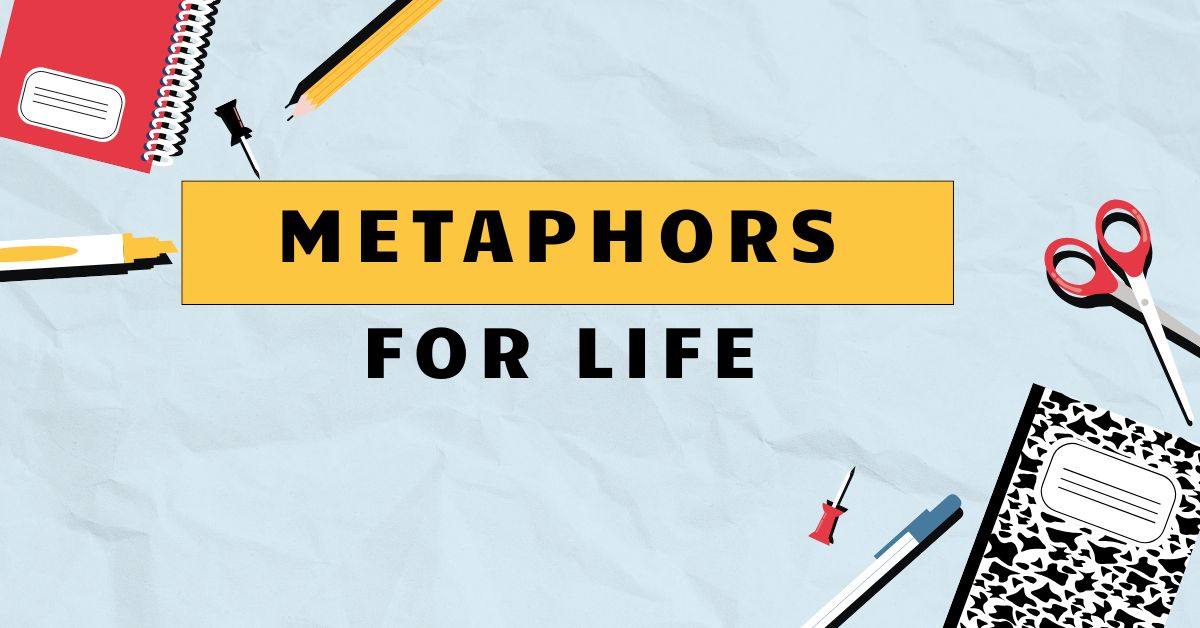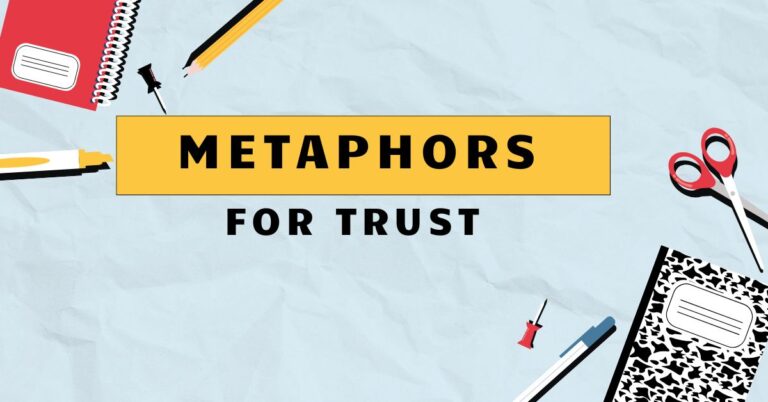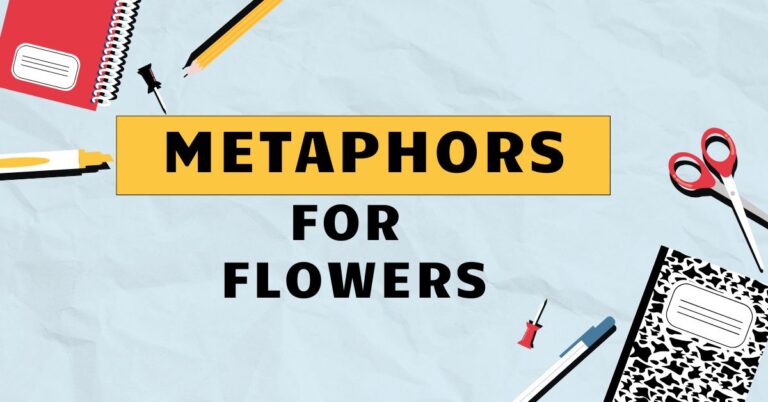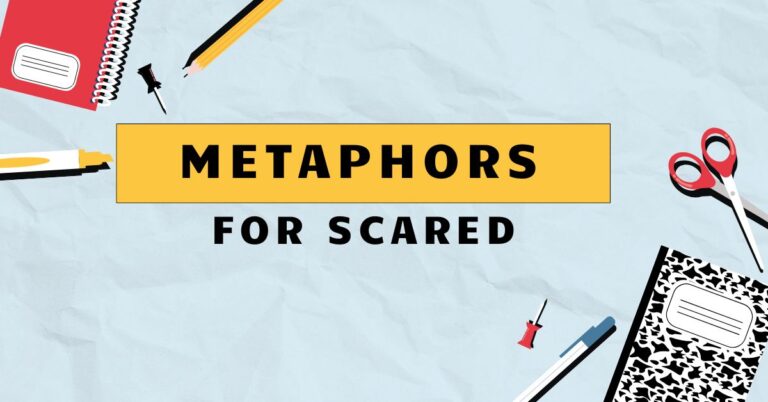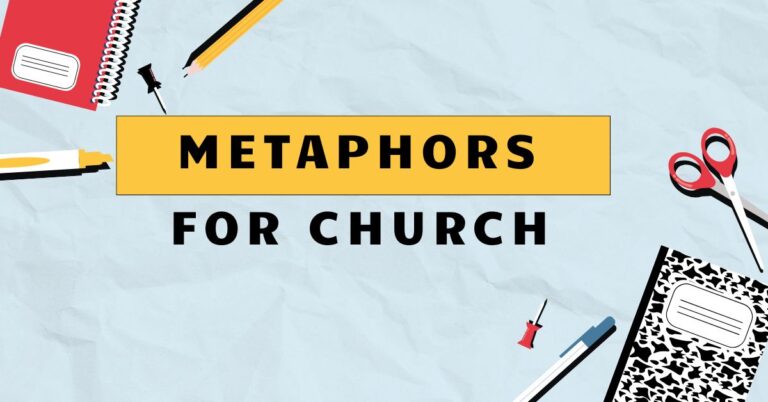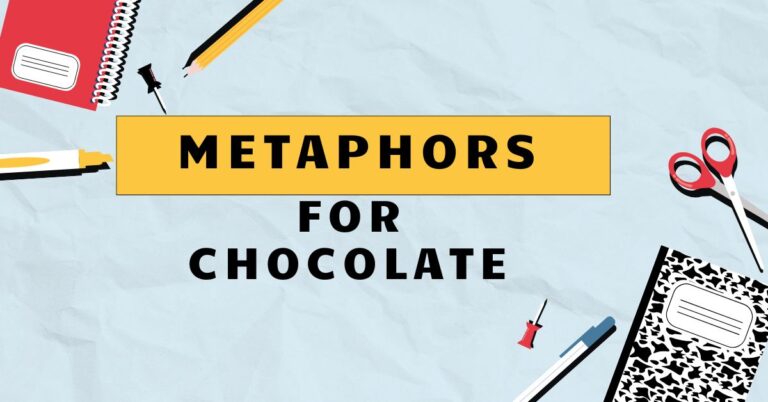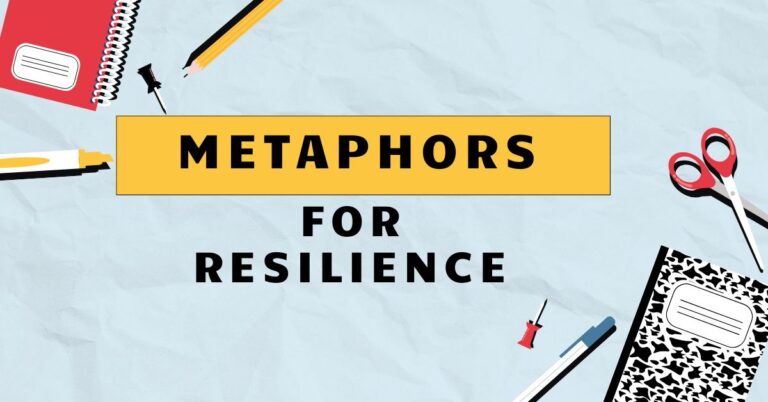39 Life’s a Stage: Mastering the Art of Metaphors for Life
Metaphors are powerful tools that enrich our language and understanding of the world. When applied to the concept of “life,” metaphors can provide profound insights, offering fresh perspectives on our experiences, challenges, and journeys.
Mastering the use of metaphors for life enhances not only our communication skills but also our ability to think critically and creatively about our existence. This article will explore the definition, structure, types, and usage of metaphors for life, providing numerous examples and practical exercises to deepen your understanding and application of this essential literary device.
Whether you’re an English language learner, a student of literature, or simply someone interested in exploring the depths of language, this guide will equip you with the knowledge and skills to effectively use and interpret metaphors in the context of life.
Table of Contents
- Definition of Metaphors for Life
- Structural Breakdown of Metaphors
- Types and Categories of Metaphors for Life
- Examples of Metaphors for Life
- Usage Rules for Metaphors
- Common Mistakes with Metaphors
- Practice Exercises
- Advanced Topics in Metaphorical Usage
- Frequently Asked Questions
- Conclusion
Definition of Metaphors for Life
Ametaphoris a figure of speech that directly compares two unrelated things without using “like” or “as.” It asserts that one thingisanother, creating a vivid and often surprising connection. When we talk about “metaphors for life,” we’re referring to statements that use this figurative language to describe or explain aspects of human existence, experiences, and journeys.
These metaphors can be powerful tools for understanding complex emotions, navigating challenges, and finding meaning in our lives.
The function of a metaphor for life is multifaceted. It can simplify abstract concepts, evoke emotional responses, and provide new perspectives.
By framing life in terms of something familiar, such as a journey, a game, or a battle, we can gain a better understanding of its complexities. Metaphors for life are commonly found in literature, poetry, philosophy, and everyday conversation, reflecting our innate human desire to make sense of the world around us.
Consider the metaphor “Life is a rollercoaster.” This doesn’t mean life literally involves riding a mechanical device. Instead, it suggests that life, like a rollercoaster, is filled with ups and downs, unexpected twists, and moments of exhilaration and fear.
This simple metaphor can convey a wealth of information about the unpredictable and emotional nature of life.
Structural Breakdown of Metaphors
A metaphor typically consists of two main elements: thetenorand thevehicle. The tenor is the subject being described (in this case, life or an aspect of it), and the vehicle is the object or concept used to describe the tenor.
The vehicle provides insight into the tenor by highlighting specific qualities or characteristics they share.
For example, in the metaphor “Life is a stage,” the tenor is “life,” and the vehicle is “stage.” The metaphor suggests that life, like a stage, involves performance, roles, and an audience. Understanding this structure helps us analyze and interpret metaphors effectively.
The relationship between the tenor and the vehicle is crucial. The connection must be meaningful and insightful, even if it’s not immediately obvious.
A good metaphor creates a resonance that deepens our understanding of the tenor. Furthermore, the context in which a metaphor is used can significantly impact its interpretation.
The surrounding words, phrases, and cultural references can influence how we understand the relationship between the tenor and the vehicle.
Types and Categories of Metaphors for Life
Metaphors for life can be categorized in various ways, depending on the aspect of life they address or the type of imagery they employ. Here are a few common categories:
Journey Metaphors
These metaphors compare life to a journey, emphasizing the process of moving forward, encountering obstacles, and reaching destinations. They often highlight themes of progress, exploration, and self-discovery.
Game Metaphors
Game metaphors frame life as a game, emphasizing competition, strategy, rules, and the pursuit of victory. These metaphors can highlight the challenges and rewards of life, as well as the importance of skill and perseverance.
Battle Metaphors
Battle metaphors portray life as a struggle or conflict, emphasizing the need for strength, resilience, and determination. These metaphors often focus on overcoming adversity and achieving victory against all odds.
Nature Metaphors
Nature metaphors draw parallels between life and the natural world, highlighting themes of growth, change, and interconnectedness. They can emphasize the beauty, fragility, and cyclical nature of life.
Performance Metaphors
Performance metaphors compare life to a performance, such as a play or a dance, emphasizing the roles we play, the masks we wear, and the audience we perform for. These metaphors can highlight the performative aspects of identity and the social pressures we face.
Examples of Metaphors for Life
Here are several examples of metaphors for life, categorized by type, to illustrate their diverse applications and meanings.
Journey Metaphors Examples
These metaphors use the concept of a journey to describe different aspects of life, such as personal growth, challenges, and experiences.
| Metaphor | Explanation |
|---|---|
| Life is a winding road. | Life has many unexpected turns and challenges. |
| Life is a marathon, not a sprint. | Success in life requires endurance and patience. |
| Life is a pilgrimage. | Life is a spiritual journey with a deeper purpose. |
| Life is a voyage of discovery. | Life is an exploration of new experiences and knowledge. |
| Life is a climb. | Life involves striving towards goals and overcoming obstacles. |
| Life is a path. | Life is a directed journey with choices and consequences. |
| Life is a scenic route. | Life is about enjoying the small moments and beauty along the way. |
| Life is a long and winding road. | Life is full of challenges and unexpected turns that require patience and adaptability. |
| Life is a road less traveled. | Life involves making unique choices and forging your own path, often diverging from societal norms. |
| Life is a journey of a thousand miles. | Life’s significant achievements come from taking small steps consistently over time. |
| Life is a continuous journey of learning and growth. | Life is an ongoing process of acquiring knowledge and evolving as an individual through experiences. |
| Life is a personal odyssey filled with trials and triumphs. | Life is an epic adventure unique to each individual, marked by challenges and victories. |
| Life is a winding river flowing towards an unknown sea. | Life is a natural progression with an uncertain future, carrying us through various experiences. |
| Life is a trek through a dense forest with occasional clearings. | Life involves navigating through complex and challenging situations with moments of clarity and relief. |
| Life is a quest for meaning and purpose. | Life is a search for significance and fulfillment, driving our actions and decisions. |
| Life is an expedition to uncharted territories of the self. | Life is an exploration of one’s inner potential and understanding one’s identity. |
| Life is a cross-country race requiring both speed and endurance. | Life demands both quick decision-making and long-term perseverance to achieve goals. |
| Life is a sail across turbulent seas, guided by stars of hope. | Life involves navigating through challenging times, using hope as a guiding principle. |
| Life is a meandering trail with unexpected vistas and hidden dangers. | Life offers surprising opportunities and potential risks along the way. |
| Life is a climb up a steep mountain with breathtaking views at the summit. | Life requires hard work and dedication, but the rewards are fulfilling and worthwhile. |
| Life is a road trip with no fixed destination, only experiences. | Life is about embracing spontaneity and enjoying the journey without strict expectations. |
| Life is an exploration of uncharted waters, with each wave a new challenge. | Life involves facing unknown difficulties and adapting to ever-changing circumstances. |
| Life is a meandering path through a garden of choices, each flower a potential outcome. | Life offers numerous options, each leading to different results and experiences. |
Game Metaphors Examples
These metaphors compare life to a game, highlighting aspects such as strategy, competition, and rules.
| Metaphor | Explanation |
|---|---|
| Life is a game of chess. | Life requires strategic thinking and planning. |
| Life is a poker game. | Life involves taking risks and making calculated decisions. |
| Life is a sport. | Life requires training, discipline, and teamwork. |
| Life is a gamble. | Life involves uncertainty and the possibility of both success and failure. |
| Life is a puzzle. | Life requires problem-solving and critical thinking. |
| Life is a game of hide-and-seek. | Life involves searching for meaning and purpose. |
| Life is a board game. | Life has rules and predetermined paths, but also elements of chance. |
| Life is a complex video game with multiple levels and challenges. | Life presents increasing difficulties as you progress, requiring skill and adaptation. |
| Life is a strategic game of risk and reward. | Life involves making choices that balance potential gains with possible losses. |
| Life is a series of puzzles that must be solved to advance. | Life requires overcoming challenges and finding solutions to move forward. |
| Life is a competitive sport where only the most dedicated win. | Life demands commitment and hard work to achieve success in any field. |
| Life is a board game with unexpected twists and turns. | Life is full of surprises and unpredictable events that alter your course. |
| Life is a casino where you bet your time and energy. | Life involves investing resources with no guarantee of a return. |
| Life is a treasure hunt with clues scattered along the way. | Life is a search for fulfillment and meaning, guided by subtle hints and experiences. |
| Life is a multi-player game where collaboration is key to success. | Life requires working together with others to achieve common goals. |
| Life is a role-playing game where you create your own character and story. | Life is about defining your identity and shaping your unique narrative. |
| Life is a game of survival where only the fittest thrive. | Life demands resilience and adaptability to overcome challenges and succeed. |
| Life is a strategic card game where timing is everything. | Life requires recognizing opportunities and acting at the right moment for maximum impact. |
| Life is a game of chance where luck plays a significant role. | Life involves elements of randomness and unpredictable events. |
| Life is a continuous game of learning and adaptation. | Life requires constantly acquiring new skills and adjusting to changing circumstances. |
| Life is like a game of musical chairs, where you must act quickly to secure your place. | Life is competitive, and you need to seize opportunities before they disappear. |
| Life is a game of tag, constantly chasing after goals and avoiding obstacles. | Life is a pursuit of ambitions, dodging challenges to reach your objectives. |
| Life is a Rubik’s Cube, complex and requiring careful manipulation to align the pieces. | Life involves solving intricate problems and balancing various aspects to achieve harmony. |
Battle Metaphors Examples
These metaphors use the concept of battle or conflict to describe life’s challenges and struggles.
| Metaphor | Explanation |
|---|---|
| Life is a battle. | Life involves constant struggles and challenges. |
| Life is a war. | Life is a fierce competition with many enemies. |
| Life is a fight for survival. | Life requires constant effort to overcome obstacles. |
| Life is an uphill battle. | Life involves facing persistent difficulties. |
| Life is a struggle. | Life is a constant effort to achieve goals. |
| Life is a battlefield. | Life is full of conflicts and challenges that require strength and resilience. |
| Life is a constant war against one’s own limitations. | Life demands overcoming personal weaknesses and pushing boundaries. |
| Life is an ongoing battle against adversity and hardship. | Life involves facing and overcoming difficult circumstances. |
| Life is a fight to protect your dreams and aspirations. | Life requires defending your goals and ambitions against opposition. |
| Life is like a boxing match, where you must be ready to take punches. | Life involves facing setbacks and being resilient in the face of adversity. |
| Life is a relentless war of attrition against time and decay. | Life is a constant struggle against aging and the limitations it brings. |
| Life is a battle for significance and recognition. | Life involves striving to make a meaningful impact and gain acknowledgment. |
| Life is a war waged on the front lines of everyday decisions. | Life requires making tough choices and facing the consequences. |
| Life is a constant struggle for balance amidst chaos. | Life involves maintaining equilibrium despite surrounding turmoil. |
| Life is a fight against the odds, where perseverance is your strongest weapon. | Life demands unwavering determination to overcome challenges. |
| Life is a defensive battle against negativity and doubt. | Life requires guarding against harmful influences and self-doubt. |
| Life is a war of attrition, testing your endurance and resilience. | Life involves long-term struggles that test your ability to persevere. |
| Life is a battle against complacency, pushing you to grow and evolve. | Life requires continuous self-improvement and resisting stagnation. |
| Life is a fight for justice and equality in an unfair world. | Life involves advocating for fairness and fighting against discrimination. |
| Life is a war against ignorance, seeking knowledge and understanding. | Life requires continuous learning and challenging misinformation. |
| Life is like a chess game, where every move is a strategic battle. | Life involves planning and making calculated decisions to achieve your goals. |
| Life is a battlefield, with each day presenting new skirmishes. | Life is filled with daily challenges that require strength and adaptability. |
| Life is a wrestling match with your fears and insecurities. | Life involves confronting and overcoming personal anxieties and self-doubt. |
Usage Rules for Metaphors
Using metaphors effectively requires careful consideration of several rules:
- Clarity: The metaphor should be understandable and relevant to the audience. Avoid obscure or confusing comparisons.
- Relevance: The vehicle should have a clear connection to the tenor, highlighting specific qualities or characteristics.
- Originality: While common metaphors can be effective, strive for originality to create a more impactful and memorable image.
- Consistency: Avoid mixing metaphors within the same sentence or paragraph, as this can create confusion and weaken the impact.
- Context: Consider the context in which the metaphor is used, including the audience, purpose, and tone.
For example, instead of saying “Life is a garden, so you should play your cards right,” which mixes the garden metaphor with a gambling metaphor, it would be better to say “Life is a garden; you reap what you sow.” This maintains the consistency of the gardening metaphor and conveys a clear message about the importance of hard work and responsibility.
Common Mistakes with Metaphors
Several common mistakes can weaken or undermine the effectiveness of metaphors:
| Mistake | Incorrect Example | Correct Example |
|---|---|---|
| Mixed Metaphors | The project is a marathon, but we need to hit the ground running. | The project is a marathon; we need to pace ourselves for the long haul. |
| Clichéd Metaphors | Life is a roller coaster. | Life is a complex tapestry woven with joy and sorrow. |
| Inappropriate Metaphors | My boss is a fluffy bunny. (Unless the intention is ironic, this is generally a poor comparison) | My boss is a hawk, always watching and ready to pounce on mistakes. |
| Overextended Metaphors | Life is a river. We must swim with the current, but sometimes we need to build a dam to control the flow, and other times we need to fish for opportunities. | Life is a river. We must learn to navigate its currents and adapt to its changing flows. |
Avoiding these mistakes will help you use metaphors more effectively and create more impactful and meaningful communication.
Practice Exercises
Test your understanding of metaphors for life with these exercises:
Exercise 1: Identifying Metaphors
Identify the metaphors in the following sentences and explain their meaning.
| Question | Answer |
|---|---|
| 1. Life is a symphony of experiences. | Metaphor: symphony. Meaning: Life is a harmonious combination of various experiences. |
| 2. He is a lion in the face of adversity. | Metaphor: lion. Meaning: He is brave and strong when facing challenges. |
| 3. Her life was an open book. | Metaphor: open book. Meaning: Her life was transparent and easily understood. |
| 4. Time is a thief. | Metaphor: thief. Meaning: Time quickly and stealthily takes away our opportunities and youth. |
| 5. The world is a stage. | Metaphor: stage. Meaning: People play different roles in life. |
| 6. Education is the passport to the future. | Metaphor: passport. Meaning: Education allows one to travel to the future and achieve their dreams. |
| 7. Life is a tightrope walk. | Metaphor: tightrope walk. Meaning: Life requires careful balance and focus to avoid falling. |
| 8. He is a shining star in the world of academia. | Metaphor: shining star. Meaning: He is exceptionally talented and accomplished in academia. |
| 9. The internet is an information superhighway. | Metaphor: superhighway. Meaning: The internet allows for rapid and extensive information access. |
| 10. Grief is a heavy burden. | Metaphor: heavy burden. Meaning: Grief is emotionally difficult to bear. |
Exercise 2: Creating Metaphors
Create metaphors for the following concepts related to life:
| Concept | Possible Metaphor |
|---|---|
| Happiness | Happiness is sunshine on a cloudy day. |
| Sadness | Sadness is a heavy rain cloud. |
| Fear | Fear is a dark shadow lurking in the corner. |
| Love | Love is a warm fire on a cold night. |
| Success | Success is a mountain peak after a long climb. |
| Failure | Failure is a detour on the road to success. |
| Hope | Hope is a fragile seed with the potential to blossom. |
| Resilience | Resilience is the ability to bend without breaking. |
| Time | Time is a river, constantly flowing. |
| Friendship | Friendship is a sheltering tree in the forest of life. |
Exercise 3: Correcting Mixed Metaphors
Correct the following mixed metaphors:
| Question | Answer |
|---|---|
| 1. The project is a rollercoaster, but we need to keep our eye on the ball. | The project is a rollercoaster; we need to prepare for the ups and downs. OR The project requires focus; we need to keep our eye on the ball. |
| 2. Life is a marathon, so we need to grab the bull by the horns. | Life is a marathon; we need to pace ourselves for the long run. OR Life requires boldness; we need to grab the bull by the horns. |
| 3. The economy is a ship sailing in rough waters, so we need to tighten our belts. | The economy is a ship sailing in rough waters; we need to navigate carefully. OR The economy is facing challenges; we need to tighten our belts. |
| 4. He’s a pillar of strength, but he also dances to the beat of his own drum. | He’s a pillar of strength, providing unwavering support. OR He’s an individualist; he dances to the beat of his own drum. |
| 5. The plan is a house of cards, so we need to think outside the box. | The plan is a house of cards; it’s fragile and easily toppled. OR We need to innovate; we need to think outside the box. |
Advanced Topics in Metaphorical Usage
For advanced learners, exploring the nuances of extended metaphors and the role of cultural context can deepen their understanding. Anextended metaphoris a metaphor that is developed over several lines or even throughout an entire work.
It allows for a more complex and nuanced comparison, creating a richer and more layered meaning. For example, a poem might use the metaphor of a ship to represent life, exploring different aspects of the ship (its sails, its crew, its journey) to illuminate different facets of the human experience.
Cultural contextplays a significant role in the interpretation of metaphors. Different cultures may have different associations with certain objects or concepts, which can influence how a metaphor is understood.
For instance, the metaphor “Life is a bridge” might evoke different images and meanings in a culture that values connection and communication compared to one that emphasizes independence and self-reliance.
Another advanced topic is the use ofmixed metaphors for stylistic effect. While generally discouraged, skilled writers can sometimes use mixed metaphors intentionally to create humor, irony, or a sense of disorientation.
However, this requires a careful understanding of the potential pitfalls and a deliberate choice to break the rules for a specific purpose.
Frequently Asked Questions
Here are some frequently asked questions about metaphors for life:
- What is the difference between a metaphor and a simile?
A metaphor directly compares two things by stating that one thing is another, while a simile uses “like” or “as” to make a comparison. For example, “Life is a journey” is a metaphor, while “Life is like a journey” is a simile. - Why are metaphors important in language?
Metaphors enrich language by adding depth, imagery, and emotional resonance. They can simplify complex concepts, provide new perspectives, and make communication more engaging and memorable. - How can I improve my ability to understand and use metaphors?
Read widely, pay attention to the metaphors used in everyday conversation, and practice creating your own metaphors. Analyze the structure and meaning of metaphors to deepen your understanding. - What are some common metaphors for life?
Some common metaphors for life include “Life is a journey,” “Life is a game,” “Life is a battle,” and “Life is a stage.” - Can a metaphor be too complex or abstract?
Yes, a metaphor can be too complex or abstract if it is difficult to understand or lacks a clear connection between the tenor and the vehicle. Clarity and relevance are essential for effective communication. - How does cultural context affect the interpretation of metaphors?
Cultural context can significantly influence the interpretation of metaphors, as different cultures may have different associations with certain objects or concepts. - What is an extended metaphor?
An extended metaphor is a metaphor that is developed over several lines or throughout an entire work, allowing for a more complex and nuanced comparison. - Is it okay to use clichéd metaphors?
While clichéd metaphors can be effective in certain contexts, they often lack originality and impact. Strive for fresh and creative comparisons to make your communication more memorable. - How can I avoid mixing metaphors?
Pay attention to the images and concepts you are using and ensure that they are consistent within the same sentence or paragraph. Avoid combining unrelated metaphors that create confusion. - What is the role of metaphors in poetry and literature?
Metaphors play a crucial role in poetry and literature, adding depth, meaning, and emotional resonance to the text. They can create vivid imagery, explore complex themes, and enhance the reader’s understanding and appreciation of the work. - Can metaphors be used in business communication?
Yes, metaphors can be used effectively in business communication to simplify complex ideas, create memorable messages, and persuade audiences. However, it’s important to use metaphors that are relevant and appropriate for the context and audience. - How do I know if a metaphor is effective?
An effective metaphor should be clear, relevant, original, and consistent. It should create a meaningful connection between the tenor and the vehicle and enhance the reader’s understanding or appreciation of the subject.
Conclusion
Metaphors for life are powerful linguistic tools that can enrich our understanding and communication. By mastering the art of creating and interpreting these metaphors, we can gain new perspectives on our experiences, navigate challenges more effectively, and express ourselves with greater clarity and impact.
Understanding the structure, types, and usage rules of metaphors is essential for effective communication in various contexts, from literature to everyday conversation. Avoid common mistakes such as mixed metaphors and clichéd comparisons, and strive for originality and relevance in your metaphorical expressions.
Continue to practice and explore the world of metaphors, and you will discover the transformative power of language to shape our thoughts, emotions, and understanding of the world. Remember to read widely, analyze the metaphors used by others, and experiment with creating your own.
With practice and dedication, you can unlock the full potential of metaphors for life and enhance your communication skills in profound ways. Embrace the journey of learning and discovery, and let the power of metaphors illuminate your path.

